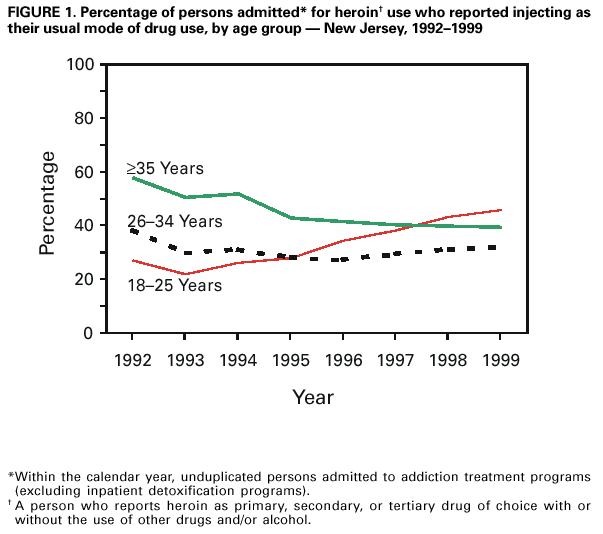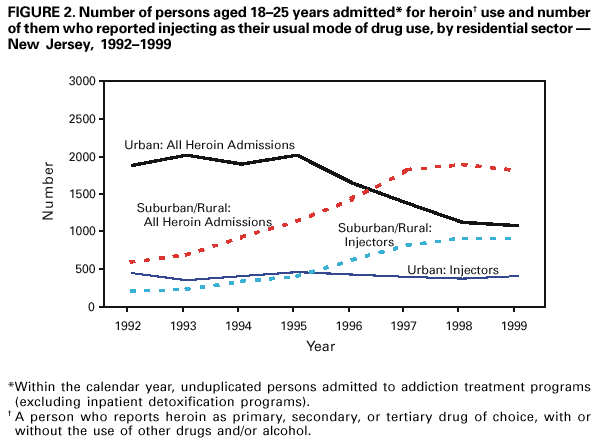 |
|
|
|
|
|
|
| ||||||||||
|
|
|
|
|
|
|
||||
| ||||||||||
|
|
|
|
|
Persons using assistive technology might not be able to fully access information in this file. For assistance, please send e-mail to: mmwrq@cdc.gov. Type 508 Accommodation and the title of the report in the subject line of e-mail. Trends in Injection Drug Use Among Persons Entering Addiction Treatment --- New Jersey, 1992--1999Injection drug use is associated with high risk for transmission of bloodborne infections, including human immunodeficiency virus (HIV) and hepatitis B and C. Since 1993, the proportion of persons admitted to New Jersey addiction treatment centers for illicit drug use who reported injecting drugs has increased, reversing a decline that began in approximately 1980 (1; Community Epidemiology Work Group, unpublished data, 2000). This report summarizes an analysis of trends in injection drug use among persons admitted to New Jersey addiction treatment programs during 1992--1999; the findings suggest substantial increases in injection use among young adult heroin users throughout the state and an increase in heroin use among young adults who reside in suburban and rural New Jersey. New Jersey's Alcohol and Drug Abuse Data System (ADADS) provided data for this report, including demographic information, client reports of substance use before entering treatment, and whether the client usually injected drugs (ADADS, unpublished data, 1999). Data were analyzed for clients admitted during 1992--1999 who reported using heroin and/or cocaine; admissions to inpatient detoxification programs were excluded. For this analysis, clients were categorized as 1) heroin users who did not use cocaine, 2) cocaine users who did not use heroin, and 3) users of both heroin and cocaine. To examine geographic patterns of heroin use and injection drug use, New Jersey cities, boroughs, and townships were categorized as either 1) urban areas including major cities (i.e., Newark, Paterson, Jersey City, Elizabeth, Camden, and Trenton) and other urban centers and surrounding areas (e.g., Atlantic City, New Brunswick, East Orange, and Hoboken) or 2) suburban and rural areas (Eagleton Institute of Politics, Rutgers University, unpublished data, 1994). From 1980 through the early 1990s, the proportion of users who injected heroin, cocaine, and both drugs declined (1; Community Epidemiology Work Group, unpublished data, 2000; ADADS, unpublished data, 1999; and New Jersey Department of Health and Senior Services, unpublished data,1991). In 1995, the proportion of heroin users reporting injection began to increase. The proportions who reported injecting drugs were, respectively, for heroin/cocaine, 43% (2810 who injected of 6514 admitted) in 1995 and 45% (2270 of 5074) in 1999; for heroin/no cocaine, 31% (3401 of 10,990) in 1995 and 37% (3796 of 10,386) in 1999. The proportions for cocaine/no heroin users were small in both years, 2% (282 of 11,609) and 2% (144 of 8142). The largest increases in the proportion of heroin/no cocaine and heroin/cocaine users who reported injecting were among clients aged 18--25 years, with increases in injecting in this age group beginning in 1993 (Figure 1). Among clients aged 18--25 years, the increase was from 22% (587 who injected of 2709 admitted for heroin use) in 1993 to 46% (1326 of 2893) in 1999. In 1993 and 1999 among persons aged 26--34 years, 30% (1802 of 5990) and 32% (1744 of 5434) were injecting; among persons aged >35 years, 50% (2624 of 5209); and 39% (2997 of 7655) were injecting. During 1993--1999, among persons aged 18--25 years, the patterns of admissions for treatment of heroin use were substantially different for those residing in urban areas compared with suburban/rural areas (Figure 2). Admissions for treatment of heroin use decreased among urban residents from 2018 in 1993 to 1076 in 1999 and increased among suburban/rural area residents from 691 to 1817. During this period, the number of young heroin users who reported injecting as their usual method of drug use increased substantially among suburban/rural residents from 232 in 1993 to 920 in 1999; the number of injectors remained approximately the same among urban residents, from 355 in 1993 to 406 in 1999. The proportion of residents who reported injecting increased in both geographic groups from 33.6% in 1993 to 50.6% in 1999 for suburban/rural residents and from 17.6% to 37.7% for urban residents. Reported by: A Kline, PhD, A Mammo, PhD, R Culleton, PhD, J Ryan, MA, R Schadl, MA, TO Connor, MPA, G Rodriguez, DSW, G DiFerdinando, MD, New Jersey Dept of Health and Senior Svcs. J French, MA, Drug-Watch Associates, Gaithersburg, Maryland. C Bruzios, PhD, P Murray, PhD, Eagleton Institute of Politics, Rutgers Univ, New Brunswick, New Jersey. Editorial Note:The findings in this report suggest substantial increases in injection use among persons admitted to New Jersey treatment centers since 1995. By 1999, the number of persons aged 18--25 years admitted for treatment of heroin use and both the number and percentage who reported injecting were higher among residents of suburban/rural areas than urban areas. Decreases in heroin use in urban areas may reflect risk reduction resulting from intensive efforts to reduce the transmission of HIV and acquired immunodeficiency syndrome in these communities (2). Another possible explanation for these changes is a substantial decrease in heroin purity. Decreased injecting among heroin users in the northeastern United States during the 1980s and early 1990s has been attributed, in part, to increases in heroin purity, from <10% to >50% (3). Purer heroin allows users to maintain their addiction by inhaling (snorting), which has a lower risk for transmission of HIV and other bloodborne infections than injecting. However, during the period of increases in the proportion of young heroin users in New Jersey who reported injecting, the purity of heroin continued to be >60%*. Another explanation may be population shifts from the cities to suburban and rural areas that may have contributed to the regional changes in heroin use and injection. However, U.S. census data for 1990 through 1998 indicate that suburban growth in New Jersey resulted from increases in the number of residents aged >35 years while the number of young adults in these regions declined. The findings in this report are subject to at least three limitations. First, data on behaviors of drug users admitted to addiction treatment programs may not be generalizable to behaviors of New Jersey heroin users not admitted for treatment. Second, changes in numbers of drug users admitted to addiction treatment may not reflect changes in numbers of drug users in the community. Third, the proportion of heroin users admitted for treatment who inject could be affected by increased outreach efforts, special treatment initiatives, or changes in IDUs' interest in treatment. In New Jersey, except for the decrease in availability of inpatient detoxification, there have been no changes in any of these factors. In response to the trend in injection drug use, in 2000, the New Jersey Department of Health and Senior Services initiated substance abuse treatment services for young heroin users who resided in the eight suburban/rural counties with the highest proportion of injecting among young heroin users. This program underscores that public health agencies can use data from substance abuse treatment programs to detect emerging drug use and injection trends, to direct and extend prevention efforts to new populations, and to reach young adults and their sex partners before they begin injecting heroin and other drugs. References
*Among 23 U.S. cities surveyed in 1999, Newark and Philadelphia (the two largest heroin distribution centers for the area) had the highest mean heroin purity levels (72% in Philadelphia and 67.5% in Newark) (Drug Enforcement Administration, Department of Justice, unpublished data, 1999). Figure 1  Return to top. Figure 2  Return to top. Disclaimer All MMWR HTML versions of articles are electronic conversions from ASCII text into HTML. This conversion may have resulted in character translation or format errors in the HTML version. Users should not rely on this HTML document, but are referred to the electronic PDF version and/or the original MMWR paper copy for the official text, figures, and tables. An original paper copy of this issue can be obtained from the Superintendent of Documents, U.S. Government Printing Office (GPO), Washington, DC 20402-9371; telephone: (202) 512-1800. Contact GPO for current prices. **Questions or messages regarding errors in formatting should be addressed to mmwrq@cdc.gov.Page converted: 5/17/2001 |
|||||||||
This page last reviewed 5/17/2001
|